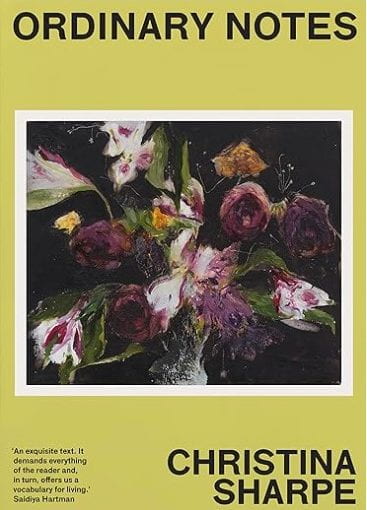I do like unusual or innovative structures and writing in books and this book has it in reams. Written as notes, some one sentence, others a couple of pages, most with a title and all thought provoking. So much so that I had to read it in small chunks, partially because of the way it is written and sometimes because of what is written. It’s a memoir, critiques, grief, descriptions, emails, letters, lists all in the exploration of antiblackness and what it means to be Black and how you see the world or how a Black person sees the world through a White person.
After visiting the Legacy Museum and the National Memorial for Peace Sharpe writes,
We understood, once again, the many ways that we are forced to encounter anew both the violence and its refusal as violence.
Can you be Black and stand there?
Note 38
Sharpe talks about the documentation of lynchings, how it is ‘hidden’, hidden but known and kept safe in attics and homes and museums across the country. In Note 43 ‘We are called to do different things’ She asks what would it be like if White people were asked to locate the white people and their families in these lynching photographs and create a Legacy of Lynching Participants database in the same way that the Legacies of British Slave Ownership project showed us who the slave-owners were, how they made their money and gained power.
What if they had to face themselves?
Might that not be a different endeavour? Might that not hit a different note?
Note 43
This note stopped me in my tracks. As she says in another note, ‘Every memorial and museum to atrocity already contains its failure’. And there were others: the critique of Obama singing Amazing Grace at the funeral of Clementa Pinckney, her childhood experiences of racism and the definitions of words as seen through Black eyes. If I had been asked to define property, I think it highly unlikely I would have written about theft of indigenous lands, theft of African bodies and enslavement, insurance and banking.
Included in the book are works of art, photographs and at the very end in the section where ‘note’ means to ‘observe with care’, Sharpe writes that the book is a love letter to her mother with a series of photographs taken from a window with condensation on it looking out – blurry and wiped out. It looks cold. And then the images move to the sky, a trail in the sky, a picture of Beloved by Toni Morrison, and the moon. It is a fascinating way to end the book.
I can’t think of another way that this book could have been written. Poetry is the nearest form I can think of that might work. The notes cover a vast range of topics, with these notes allowing the author to roam. Some stand alone in the text, others follow on but all lead to seeing the world through the Black gaze.
The notes are like stars in the sky. Some shine brightly, others less so, with each as an individual but together they make a constellation.
This book is on my list of the best books I have read in 2024.
